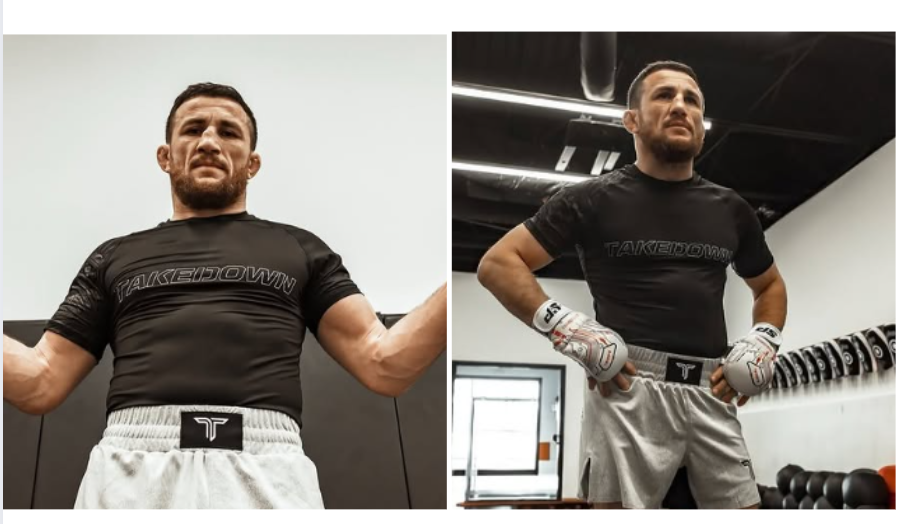Merab Dvalishvili, who is only 5 feet 6 inches tall, competes in a division where reach is usually viewed as an advantage and every inch is frequently counted. However, since his early UFC setbacks, Merab has been remarkably effective in almost every appearance, redefining what height means in combat sports. His physique is now seen as a strength rather than a weakness, especially when it comes to pressure-based combat and unrelenting grappling.

By emphasizing volume, tempo, and placement over reach, Merab has created a style that is remarkably akin to a locomotive—once momentum is established, it is impossible to stop. Both his stand-up striking and submission control have significantly improved during his record-breaking run, which now includes 13 straight wins. He demonstrates an extraordinarily adaptable style in every fight, switching between fast combos and fluid takedown chains that leave opponents unsure of what to do.
Merab Dvalishvili Bio and Career Overview
| Attribute | Detail |
|---|---|
| Full Name | Merab Dvalishvili |
| Nickname | The Machine |
| Date of Birth | January 10, 1991 |
| Age | 34 |
| Birthplace | Tbilisi, Georgian SSR, Soviet Union |
| Nationality | Georgian, American |
| Height | 5 ft 6 in (1.68 m) |
| Weight | 135 lb (61 kg) |
| Division | Bantamweight |
| Reach | 68 in (173 cm) |
| Team | Serra-Longo Fight Team |
| Coaches | Ray Longo, Matt Serra |
| Fighting Out Of | Long Island, New York, USA |
| Martial Arts Rank | Black belt in Judo, Purple belt in Brazilian Jiu-Jitsu |
| Years Active | 2014–present |
| UFC Record | 13-fight win streak since 2018 |
| Current Title | UFC Bantamweight Champion (since Sep 2024) |
| Official UFC Profile |
Because of his height, Merab is able to maintain a lower center of gravity, which gives him remarkable balance during transitions and clinch exchanges. That quality, which is frequently underappreciated, has been very helpful in achieving high-level victories over strong opponents like Sean O’Malley, Petr Yan, and José Aldo. In addition to making him the UFC Bantamweight Champion, his triumph over O’Malley in September 2024 reaffirmed that greatness can be attained with sheer willpower rather than great size.
Merab showed how his size could be used strategically in his rematch with O’Malley. He took less damage, closed distance quickly, and ultimately performed a faultless submission that astounded the MMA community by remaining grounded and compact. It was a pivotal moment in his career, and his story—immigrating, working hard at construction jobs, and rising through the ranks via sheer willpower—made it even more inspirational.
Merab’s presence has sparked a larger movement in the sport in recent years. Once disregarded due to their smaller stature, fighters are now being reassessed. His ascent is similar to past tales like the championship run of Frankie Edgar, a fighter who was also 5’6″ but consistently outperformed taller opponents. These accounts demonstrate a changing trend: height advantages are no longer the only factor in MMA success, particularly in the bantamweight and featherweight classes.
Merab has created a hybrid style by combining methods from Brazilian Jiu-Jitsu and Judo. His background in Sambo, demonstrated by his gold in the 2024 U.S. National Combat Sambo Tournament and silver medal in the 2019 World Championships, translates into top control and dynamic throws that are rarely seen with such fluidity. His toolkit is further strengthened by the fact that he trains under Matt Serra and Ray Longo. Their ideas, which are based on tenacity and fortitude, perfectly complement Merab’s inherent qualities.
Through strategic alliances and training with UFC athletes like Aljamain Sterling, he has joined a new MMA brotherhood of fighters who support and encourage one another. That friendship has had a particularly significant influence, providing not only psychological support but also technological advancements that are clearly having an effect. Sterling has frequently acknowledged that Merab had an impact on his strategy for fighting readiness.
Merab has become more than just an athlete to Georgian fans; he is a representation of what is possible with tenacity. He was widely commended for his kind donation of the full 1 million Georgian Lari prize money he received for winning the UFC title, which he used to fund grassroots grappling programs in his native country. This gesture, which is firmly rooted in community values, speaks to his character. Interestingly, it has aroused interest in MMA among a new generation of Georgian athletes.
At first glance, Dvalishvili’s height may seem unimpressive in comparison to contemporary champions. However, his findings are more powerful than any cheesy graphics. His height has sharpened him rather than hindered him. Through constant learning, extensive training, and strategic tactic adaptation, he has established a career that is not only incredibly effective but also remarkably resilient.
His ability to simplify complexity is one of the most remarkable features of his ascent. He acts with calculated aggression whether he is rushing for position, starting takedowns, or defending against longer strikers. This economy of movement has maximized scoring while drastically cutting down on needless damage. In a field where durability, accuracy, and speed must coexist, that is especially creative.
Merab’s rise is a powerful counter-narrative in the context of athlete identity. He defines himself through action, heart, and relentless pace rather than by lofty stats. His performances convey a message that extends well beyond the octagon: one’s ability to succeed depends on how they hone and use their innate qualities.
Dvalishvili has changed from being a grinder to a finisher since he started his MMA career in 2014. By doing this, he has succeeded in bridging the gap between technical mastery and popular appeal. His fights, which are full of pressure, scrambles, and relentless movement, are not only technically interesting but also emotionally captivating.
